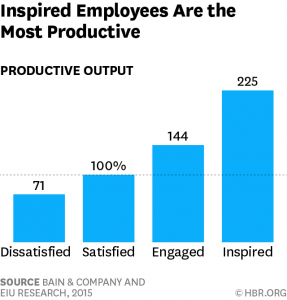Last week I looked at what gives a company its competitive edge, but often overlooked as a competitive advantage is the people inside the company. In fact, sadly in some businesses, their people are treated as simply a cost that needs cutting. In times of recession staffing costs are obviously a target for cost savings and job security becomes an issue. People intensive institutions such as schools and health services face a dilemma when cutting back on staffing; reducing employee numbers directly affect service delivery, but staffing is their highest cost and an obvious target for savings.
Harness your good people for competitive advantage
How does a business retain good employees, keep staffing costs manageable and at the same time keep their competitive position in a market? It requires a shift in thinking from seeing staff costs as a resource rather than a burden. It seems ironic that personnel management is now known as human resources yet some companies still see their employees as no more than a balance sheet number. I would argue that people are the lifeblood of any company and can make or break its’ profitability.
 The competitive advantage good human resources can give a business can be seen in a number of ways. Great customer service retains existing customers and attracts new ones. This comes down to how connected to the business objectives employees are and how invested in its success that they feel. The John Lewis Partnership, for example, literally employs everyone as a partner in the business. It is an unusual form of business ownership for retail more commonly seen in professional areas such as accountancy and the law. For John Lewis it works and despite being more expensive than some of its competitors their focus on quality, staff involvement and that extra customer service attitude has proved successful.
The competitive advantage good human resources can give a business can be seen in a number of ways. Great customer service retains existing customers and attracts new ones. This comes down to how connected to the business objectives employees are and how invested in its success that they feel. The John Lewis Partnership, for example, literally employs everyone as a partner in the business. It is an unusual form of business ownership for retail more commonly seen in professional areas such as accountancy and the law. For John Lewis it works and despite being more expensive than some of its competitors their focus on quality, staff involvement and that extra customer service attitude has proved successful.
The people working in a business are often an untapped source of ideas and can directly add a competitive advantage by being the closest to understanding customer needs and desires. Rather than spend huge amounts on expensive market research consultants, ask the people working for you what they think customers want. Smart companies go beyond employee suggestion boxes to structured staff councils that can directly influence a company’s direction.
The people inside a business can be very inventive about working practices when they understand it is a cost that needs managing. When employees feel under threat of redundancy, it can go one of two ways. Either it becomes staff vs management and combative and ugly or it becomes a cooperative effort to save money.
Engaged and inspired employees make companies money
If you want to be truly competitive then you need your employees to be productive. Sickness levels on the rise show employee dissatisfaction as do an increase in work related accidents. The opposite effect is that inspired employees can contribute a significant increase in productivity. Research by Bain and Company and the Economic Intelligence Unit found startling results on engagements’ impact on productivity. (see the image below)
From a purely quantitative perspective, in other words, it would take two and a quarter satisfied employees to generate the same output as one inspired employee.
https://hbr.org/2015/12/engaging-your-employees-is-good-but-dont-stop-there
Much of this comes down to inspirational leadership and reducing bureaucracy. Another factor is the level of involvement employees feel in the company- in other words how much is their contribution valued and their opinions respected?
Working methods and competitive advantage
Rather than “downsizing” your workforce to save money a smart company looks to gain the most from its employees. Simply cutting back employee numbers does not make for efficiency- often the remaining staff are stressed and under pressure from increased workload and become inefficient and disaffected. Set the workforce the challenge of solving the customer problems; they often know a smarter way of doing their own job and working cooperatively will come up with cost efficient methods. Establish “upskilling” programs where skilled staff improve the skill levels of junior employees through mentoring and training programmes. Both trainer and trainee will benefit from increased levels of motivation. Understanding the power of a motivated workforce is key to competitive advantage. I have often spoken at company events with the focus on motivation as companies know it has the power to increase productivity.
Establish challenge as a whole company objective- if employees feel involved in solving problems they are more likely to come up with solutions. When facing competitive activity, it is all too easy to see it simply as a cost reduction exercise. Having a real competitive advantage is much more about efficient systems and innovative thinking.
Before looking outside of the company at your competitors, wringing your hands and feeling you are losing the race- look inside. You may well have the answer to gaining competitive advantage within your workforce. Tap into their knowledge and inspire them to move the company towards competitive success.


